
The Blond Ambition World Tour was the third concert tour by American singer Madonna. It supported her fourth studio album Like a Prayer (1989), and the soundtrack album to the 1990 film Dick Tracy, I'm Breathless. The 57-show tour began on April 13, 1990, at the Chiba Marine Stadium in Chiba, Japan, and concluded on August 5, 1990, at the Stade Charles-Ehrmann in Nice, France. Additionally, it marked Madonna's first concerts in Sweden and Spain. Originally planned as the Like a Prayer World Tour, it was supposed to be sponsored by soft drink manufacturer Pepsi. However, the company cancelled the contract following the controversy surrounding the music video of "Like a Prayer".
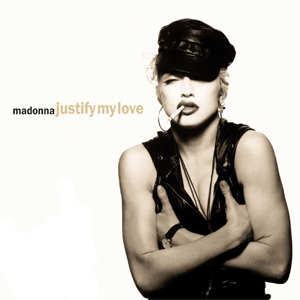
"Justify My Love" is a song released as a single by American singer Madonna. It does not appear on any of her studio albums, but is included on her first greatest hits album, The Immaculate Collection (1990). The song was written by Lenny Kravitz and Ingrid Chavez, with additional lyrics by Madonna; Kravitz also handled the production alongside André Betts. It was released as the lead single from The Immaculate Collection on November 6, 1990, by Sire and Warner Bros. Records. Chavez was not credited on the song, which led to a lawsuit against Kravitz, eventually reaching an out-of-court settlement. Musically considered as a hip hop, dance, trip hop, and experimental pop track, it features spoken word vocals by Madonna as she releases her inner freak, touching on sexual fantasies and implying the position of a woman as the one sexually in control.

Like a Prayer is the fourth studio album by American singer-songwriter Madonna, released on March 21, 1989, by Sire Records. It saw the singer reunited with Patrick Leonard and Stephen Bray, with whom she had collaborated on her previous studio album True Blue (1986), and the soundtrack to the 1987 film Who's That Girl; artist Prince also collaborated on the record, co-writing and co-producing one of the tracks alongside Madonna. Her most introspective release at the time, Like a Prayer is a pop record with elements of rock and dance pop. Its lyrics deal with personal themes she had been too afraid to approach up at that point: her Catholic upbringing, her troubled marriage to actor Sean Penn, the death of her mother, and her relationship with her father.

"Papa Don't Preach" is a song by the American singer-songwriter Madonna, released on her third studio album True Blue (1986). It was written by Brian Elliot with additional lyrics by Madonna, and produced by Madonna and Stephen Bray. "Papa Don't Preach" combines pop and classical styles, with lyrics about teenage pregnancy, and the choices that come with it. Elliot was inspired by the teen gossip he heard outside his recording studio.

"Material Girl" is a song recorded by American singer Madonna for her second studio album, Like a Virgin (1984). It was released on January 23, 1985, by the Sire label as the second single from Like a Virgin. It also appears slightly remixed on the 1990 greatest hits compilation, The Immaculate Collection, in its original form on the 2009 greatest hits compilation, Celebration and Finally Enough Love: 50 Number Ones (2022). The song was written by Peter Brown and Robert Rans, and produced by Nile Rodgers. Madonna said the concept of the song was indicative of her life at that time, and she liked it because she felt it was provocative.

The Drowned World Tour was the fifth concert tour by American singer-songwriter Madonna in support of her seventh and eighth studio albums Ray of Light (1998) and Music (2000), respectively. The tour began on June 9, 2001, at the Palau Sant Jordi in Barcelona, Spain, and ended on September 15 at the Staples Center in Los Angeles, United States. It was her first tour in eight years, following the Girlie Show in 1993. Set to start in 1999, it was delayed until 2001 as Madonna filmed and starred in the movie The Next Best Thing (2000), began working on Music, gave birth to her son Rocco and married Guy Ritchie.

"Like a Virgin" is a song recorded by American singer Madonna from her second album of the same name. The song was written and composed by Tom Kelly and Billy Steinberg, and it was released as the album's lead single on October 31, 1984. A dance song with two hooks, Madonna sings in a high register while a continuous arrangement of synths are heard along the bassline. The song's lyrics are ambiguous, consisting of hidden innuendos and open to various interpretations.

"Causing a Commotion" is a song by American singer Madonna from the soundtrack album to the 1987 film Who's That Girl. It was released as the album's second single on August 25, 1987, by Sire Records. Its Silver Screen Single Mix later appeared on the EP The Holiday Collection (1991). Written and produced by Madonna and Stephen Bray, the song was inspired by her relationship with then-husband Sean Penn, and his abusive and violent nature. Containing a dance-oriented, up-tempo groove, the song begins with the chorus and is accompanied by a four-note descending bassline and staccato chords in the verses.
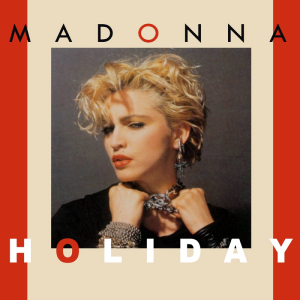
"Holiday" is a song by American singer Madonna from her self-titled debut album (1983). It was written by Curtis Hudson and Lisa Stevens-Crowder for their own musical act Pure Energy, and produced by John "Jellybean" Benitez. Hudson came up with the lyrics of the song while watching negative news on television, and together with Stevens-Crowder worked on the music. They recorded a demo, which was turned down by their label Prism Records. Afterwards, Benitez pitched the track and offered it to several artists, including former The Supremes singer Mary Wilson, but it was rejected. Around the same time, Benitez was working with Madonna on her album; after realizing they needed a song for the project, Benitez thought of "Holiday" and approached Hudson and Stevens-Crowder.

"Into the Groove" is a song recorded by American singer Madonna, and featured on the 1985 film Desperately Seeking Susan. Written and produced by both Madonna and Stephen Bray, the main inspiration behind the song was the dance floor; the singer wrote it while watching a Latin American man to whom she was attracted. Its instrumentation features synthesizers and drum machines, with Madonna's voice being double tracked on the chorus. Sexual innuendos and undertones are present throughout the lyrics, which are written as an invitation to dance with the singer. Originally written for her friend Mark Kamins, Madonna later decided to use it on the film, as one of the scenes needed a dance song. It was later added to the 1985 international re-issue of her second studio album, Like a Virgin (1984), and in her compilations You Can Dance (1987), The Immaculate Collection (1990), Celebration (2009), and Finally Enough Love: 50 Number Ones (2022).

"Live to Tell" is a song by American singer Madonna from her third studio album, True Blue (1986). The song was composed by Patrick Leonard as an instrumental for the score of Paramount's film Fire with Fire, but Paramount rejected it. Leonard then presented the track to Madonna, who decided to use it for At Close Range, a film starring her then-husband Sean Penn. Madonna wrote the lyrics, co-composed the melodies and co-produced it with Leonard. "Live to Tell" was released as True Blue's lead single in 1986, by Sire Records; afterwards, it was included on Madonna's compilation albums The Immaculate Collection (1990), Something to Remember (1995), and Celebration (2009). A pop ballad, the song includes instrumentation from guitars, keyboards, drums and a synthesizer, while the lyrics deal with deceit, mistrust and childhood scars; Madonna also recalled in an interview that she thought about her relationship with her parents while writing the lyrics.

"Open Your Heart" is a song recorded by American singer Madonna from her third studio album True Blue (1986). Written by Gardner Cole and Peter Rafelson, it was conceived as a rock and roll song titled "Follow Your Heart" for singer Cyndi Lauper, although it was never played for her. At the time, Cole's management was working with Madonna's, who were looking for material for True Blue. "Follow Your Heart" was among the songs offered to the singer. She liked it and, alongside producer Patrick Leonard, turned it into a dance song, changed its title and re-wrote some of the lyrics, thus receiving a songwriting credit.
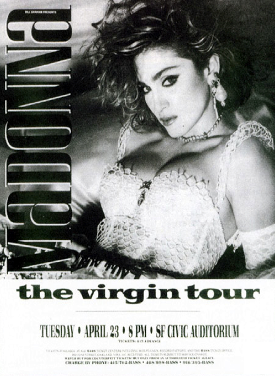
The Virgin Tour was the debut concert tour by American singer-songwriter Madonna. The tour supported her first two studio albums, Madonna (1983) and Like a Virgin (1984). It started on April 10, 1985, at the Paramount Theatre in Seattle, United States, and ended on June 11 of the same year at the Madison Square Garden in New York City. Although initially planned for an international audience, the tour was restricted to the United States and Canada. Warner Bros. Records decided to send Madonna on tour after Like a Virgin became a success. After an official announcement on March 15, 1985, Madonna and her team began production plans. She wanted the tour to be a reflection of her own self and collaborated with designer Maripol for the costumes.
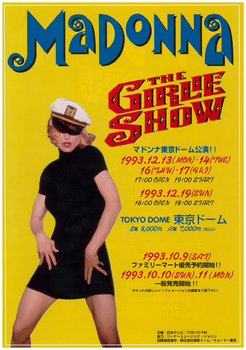
The Girlie Show was the fourth concert tour by American singer and songwriter Madonna, in support of her fifth studio album, Erotica (1992). It began on September 25, 1993, at the Wembley Stadium in London, England, and ended on December 19 of the same year at the Tokyo Dome in Tokyo, Japan.
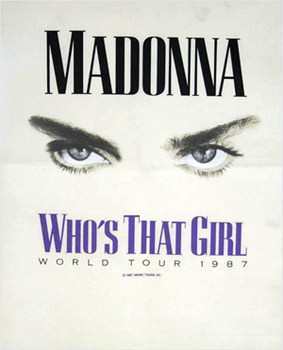
The Who's That Girl World Tour was the second concert tour by American singer and songwriter Madonna. The tour supported her 1986 third studio album True Blue, as well as the 1987 soundtrack Who's That Girl. It started on June 14, 1987, at the Osaka Stadium in Osaka, Japan, and ended on September 6 of the same year at the Stadio Artemio Franchi in Florence, Italy. It was Madonna's first world tour and marked her first visits to Japan and Europe. Musically and technically superior to her previous Virgin Tour, Who's That Girl incorporated multimedia components to make the show more appealing.
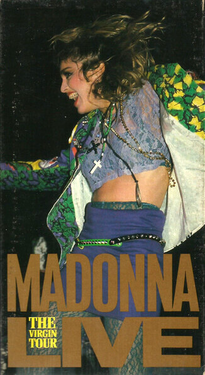
Madonna Live: The Virgin Tour is the second video album and the first live release by American singer-songwriter Madonna. It was released by Warner Music Video and Sire Records on November 13, 1985 and contains the concert footage from The Virgin Tour, filmed at Cobo Arena in Detroit, Michigan on May 25, 1985. Director Daniel Kleinman, who presided over the shooting of the tour on video, submitted the footage to Warner Bros. Records, who decided to release it as a video album. Madonna wanted to have a proper introduction added before the concert footage and asked director James Foley to shoot one, which portrayed her with her first image makeover, reciting lines related to how she became famous.

"Keep It Together" is a song by American singer Madonna from her fourth studio album, Like a Prayer (1989). It was released as the fifth and final single from the album in the United States, Canada and Japan on January 30, 1990, by Sire Records. Written and produced by Madonna and Stephen Bray, the main inspiration behind "Keep It Together" was Madonna's relationship with her family—whom she dearly missed during her divorce from Sean Penn. The song was dedicated to the American band Sly and the Family Stone. The lyrics deal with the realization of how important Madonna's family has been to her life. A pop, funk and deep funk song consisting of an upbeat rhythm and groove, "Keep It Together" features instrumentation from percussion, banjo and a conga.

The Girlie Show: Live Down Under is a video album by American singer-songwriter Madonna. It was released by Warner-Reprise Video, Maverick and Sire Records on April 26, 1994, on VHS and Laserdisc formats and included the concert that took place on November 19, 1993, at Sydney Cricket Ground from The Girlie Show. The concert had previously been broadcast on American network HBO as Madonna Live Down Under: The Girlie Show and became the channel's most-watched original program of the year. The video received generally positive reviews from music critics, and reached numbers one and three in the music videos charts in the United Kingdom and the United States, respectively. At the 37th Grammy Awards, it was nominated for Best Long Form Music Video. It was released on DVD in 1998, becoming one of the first music videos to be published in this format.

Ciao Italia: Live from Italy is a video album by American singer-songwriter Madonna and was released by Warner Reprise Video and Sire Records on May 24, 1988. It contained footage from a previous TV special of the Who's That Girl World Tour, Madonna in Concerto, broadcast in Europe in 1987, filmed at the Stadio Comunale in Turin, Italy. The video release also contained footage from shows recorded in Florence, Italy and Tokyo, Japan, the latter having previously been released as a Japanese TV special and home video release, Who's That Girl: Live in Japan. The decision to release Ciao Italia was spurred by the fact that this previous release became a commercial success in Japan. A re-release of the video took place in 1999, when it was released in DVD format, with a stereo soundtrack containing the songs only.



















